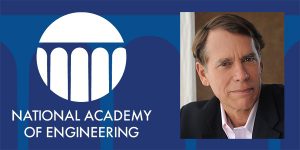
Daniel B. Stephens & Associates, Inc. (DBS&A) Founder and Principal Hydrologist, Daniel B. Stephens, Ph.D., P.G., P.Hg., has been elected to become a member of the National Academy of Engineering (NAE) for his innovations in vadose zone hydrology. Election to the NAE is among the highest professional distinctions. This membership honors those who have made outstanding contributions to engineering research, practice, or education and to “the pioneering of new and developing fields of technology, making major advancements in traditional fields of engineering, or developing/implementing innovative approaches to engineering education.” The induction ceremony will be held in Washington, D.C. on October 6, 2019, where he will be 1 of 86 new members and 18 foreign members.
Dr. Stephens has more than 40 years of experience in consulting, research, and academia. He is recognized internationally as an authority on vadose zone and groundwater hydrology. During his academic career, Dr. Stephens was on the faculty of New Mexico Institute of Mining and Technology (NM Tech), where he taught graduate-level courses in subsurface hydrology, including a pioneering course on vadose zone hydrology, in addition to conducted a vigorous applied research program, and serving a period as department chair.
Dr. Stephens began private consulting in 1976 and founded DBS&A in 1984. With a modest start in Socorro, New Mexico, DBS&A grew to a $17-million corporation with seven offices in California, New Mexico, Colorado, and Texas. In 2015, DBS&A joined forces with Geo-Logic Associates (GLA) and now has 27 offices and more than 250 employees.
Much of Dr. Stephens’ career has centered around putting theory into practice, especially as his training in hydrogeology has focused on soil physics and the vadose zone. Dr. Stephens’ has made a positive impact in myriad ways, including:
- Writing his dissertation, which developed a new field method to quantify hydraulic conductivity.
- Developing the first university course on vadose zone hydrology.
- Training more than 20 graduate students in hydrology in a brief academic career.
- Publishing research in our top journals, which added to our conceptual understanding of flow and transport in soil.
- Publishing the first text book on vadose zone hydrology, which brought overdue recognition for this aspect of subsurface hydrology.
- Communicating through more than 140 conference presentations and short courses that the vadose zone is an integral part of groundwater hydrology.
- Building a firm of scientists and engineers to serve the needs of companies and agencies struggling to comply with new government regulations.
- Providing jobs to nearly 600 scientists, engineers, and other professionals in six states since 1984 in a work environment that encouraged talented staff to patent their ideas.
- Starting a commercial soil testing laboratory that today is likely the largest of its kind in the U.S.
- Providing high-level expertise to the Department of Energy (DOE), our national laboratories, and other organizations on some of the nations most contaminated sites.
Today, in part due to Dr. Stephens’ career, practitioners have a much better understanding of the vadose zone and its role in replenishing and protecting our aquifers.
Dr. Stephens published Vadose Zone Hydrology in 1995. The text illustrates the application of soil physics to practical problems relevant to the characterization and monitoring of the vadose zone and highlights new and emerging technologies for monitoring the vadose zone, particularly for the purpose of detecting contaminants. The book presents case studies that demonstrate the practical application of the subject matter rather than offering a dry discussion on the subject. Duane Hampton, a former professor who used Stephens’ textbook for a graduate-level Geology course stated, “A lot of unsaturated zone books have been published in the past several years, but none of the others were suitable.”
Dr. Stephens served on a number of scientifically influential boards, committees and panels. He served on the Board of Directors of the National Ground Water Association (NGWA). He also chaired the National Vadose Zone Science and Technology Roadmap Executive Committee for the U.S. DOE in development of a national interdisciplinary research program. The program identified knowledge gaps that are impeding clean up or stabilization of subsurface contamination. Also notable are his contributions to an expert panel on unsaturated zone systems at Yucca Mountain as part of the evaluation of the site’s suitability for permanent disposal of radioactive waste. In addition, Dr. Stephens was the Chair of the Peer Review Team for the DOE, Technology Innovation and Development, Office of Environmental Management, Advance Simulation Capability for Environmental Management Division. He participated in the Blue Ribbon Panel to review hydrogeologic data needs for the Environmental Restoration Program at Los Alamos National Laboratory. Dr. Stephens was also asked to participate on the review committee for the Ernest Orlando Lawrence Berkeley Laboratory, Oakland, California, Earth Sciences Division.
Dr. Stephens has received several important awards honoring his contributions. In 2017, he was selected as the recipient of the Groundwater Resources Association (GRA) of California’s Lifetime Achievement Award. In 2016, he was awarded the Keith E. Anderson Award from the NGWA in recognition of his significant contributions and commitment to the NGWA Scientists and Engineers Division. In 2010, he was recognized by the New Mexico Business Weekly as a Who’s Who in Technology Honoree. And, in 2004, he received the University of Arizona Alumni Association’s Sydney S. Woods Alumni Service Award.
Learn more about Dr. Daniel B. Stephens.
Learn more about DBS&A’s Vadose Zone Hydrology.
Learn more about the NAE 2019 election.
